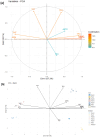Gastroprotective, Antioxidant, Anti-Inflammatory, and Toxicological Evaluation of Stem Bark Extracts of Vitellaria paradoxa and Parkia biglobosa
- PMID: 40872575
- PMCID: PMC12389382
- DOI: 10.3390/ph18081184
Gastroprotective, Antioxidant, Anti-Inflammatory, and Toxicological Evaluation of Stem Bark Extracts of Vitellaria paradoxa and Parkia biglobosa
Abstract
Background/Objectives: Oxidative stress is a pathophysiological factor that causes challenging issues in the treatment of several diseases, including gastric ulcer, inflammatory diseases, and adenocarcinomas. V. paradoxa and P. biglobosa are African plants whose parts are used for treating diseases, including gastrointestinal pathologies. This study aimed to characterize the gastroprotective, antioxidant, and anti-inflammatory activities of V. paradoxa and P. biglobosa stem bark extracts based on various solvents. Methods: The phytochemical screening and antioxidant evaluation were performed using radical scavenging (ABTS and DPPH) and reduction (FRAP and APM) methods. The anti-inflammatory activity was performed through an egg albumin denaturation model. The toxicological evaluation was performed on Artemia salina and female Wistar rat models, and the gastroprotective activity was carried out on an ethanolic-induced gastric ulcer rat model. Results: The results reported that V. paradoxa stem bark extracts contain catechin, epicatechin, ferulic acid, apigenin-7-gluc, and hesperidin, while P. biglobosa bark contains chlorogenic acid, catechin, caffeine, epicatechin, and cichoric acid. In the DPPH assay, the lowest scavenging capacities were 1.8 ± 0.21 mmol AAE/mg of dry extract (V. paradoxa, 97% ethanol) and 11.43 ± 0.208 mmol AAE/mg of dry extract (P. biglobosa, 50% ethanol). Similarly, for ABTS, the lowest scavenging capacities were 0.9726 ± 0.03952 mmol AAE/mg of dry extract (V. paradoxa, methanol with 1% HCl) and 1.3 mmol AAE/mg of dry extract (P. biglobosa, 97% ethanol), indicating strong antioxidant capacity. In the FRAP assay, both species reached a maximum reducing power of 2.39 mMol AAE/mg of dry extract (methanolic extract for V. paradoxa; methanol + 1% HCl for P. biglobosa). For APM, the 97% ethanolic extracts again showed the highest total antioxidant capacities: 31.78 ± 1.481 mMol AAE/mg (V. paradoxa) and 31.21 ± 0.852 mMol AAE/mg (P. biglobosa). The stem bark extracts of both V. paradoxa and P. biglobosa were revealed to be harmless in the Artemia salina as well as the rat model. The extracts of V. paradoxa as well as P. biglobosa exerted a stronger gastroprotective effect than omeprazole, a commonly used reference molecule. Conclusions: These extracts, rich in compounds exhibiting strong antioxidant, anti-inflammatory, and gastroprotective activities, surpassed omeprazole in ulcer protection in rat models. Their safety was confirmed in both Artemia salina and rodent assays. Future studies will explore their immunomodulatory, antiproliferative activities in vitro and in vivo and, specifically, the efficacy of isolated compounds in gastric adenocarcinoma models to assess these plants' anticancer potential and elucidate their underlying mechanisms.
Keywords: Parkia biglobosa extract; Vitellaria paradoxa extract; gastroprotection; oxidative stress; phytochemicals.
Conflict of interest statement
Author Justinian Andrei Tomescu was employed by the company Hofigal Export Import S.A. The remaining authors declare that the research was conducted in the absence of any commercial or financial relationships that could be construed as a potential conflict of interest.
Figures



























Similar articles
-
Prescription of Controlled Substances: Benefits and Risks.2025 Jul 6. In: StatPearls [Internet]. Treasure Island (FL): StatPearls Publishing; 2025 Jan–. 2025 Jul 6. In: StatPearls [Internet]. Treasure Island (FL): StatPearls Publishing; 2025 Jan–. PMID: 30726003 Free Books & Documents.
-
Phytochemical Screening and Biological Activities of Lippia multiflora Moldenke.Molecules. 2025 Jul 7;30(13):2882. doi: 10.3390/molecules30132882. Molecules. 2025. PMID: 40649396 Free PMC article.
-
Comprehensive phytochemical characterization, antioxidant potency, and toxicological evaluation of Paederia foetida in Wistar albino rats: Insights into therapeutic efficacy and safety profiles.J Ethnopharmacol. 2025 Sep 25;353(Pt B):120382. doi: 10.1016/j.jep.2025.120382. Epub 2025 Aug 13. J Ethnopharmacol. 2025. PMID: 40816589
-
The Black Book of Psychotropic Dosing and Monitoring.Psychopharmacol Bull. 2024 Jul 8;54(3):8-59. Psychopharmacol Bull. 2024. PMID: 38993656 Free PMC article. Review.
-
The quantity, quality and findings of network meta-analyses evaluating the effectiveness of GLP-1 RAs for weight loss: a scoping review.Health Technol Assess. 2025 Jun 25:1-73. doi: 10.3310/SKHT8119. Online ahead of print. Health Technol Assess. 2025. PMID: 40580049 Free PMC article.
References
LinkOut - more resources
Full Text Sources
Miscellaneous

